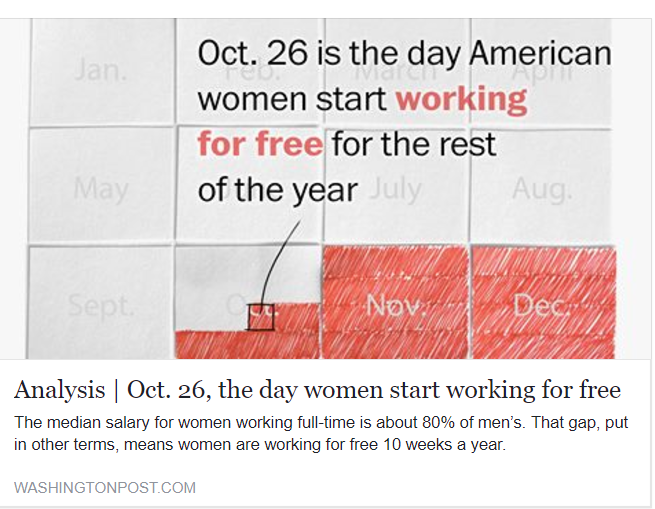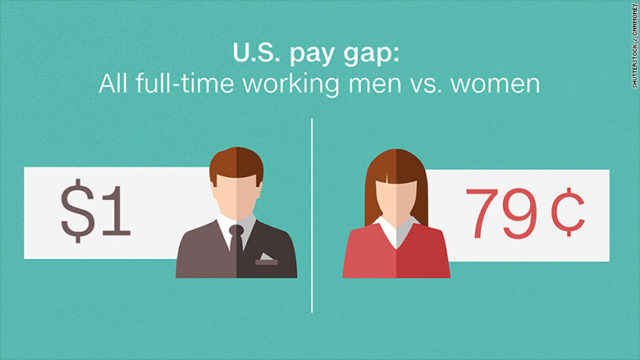Recently, the Washington Post took it upon themselves to regurgitate – once again – the myth that there is a gender pay divide with a deliberately obtuse headline
The guiding idea is that, because women make 77% of what men make for the “same work”, that from Oct.26 to the end of the year women work for free. That statement isn’t true, and here’s why.
The 23-cent gender pay gap is just the difference between the average earnings of all men and women working full-time. That’s absurd. It does not account for differences in occupations, positions, education, job tenure, or hours worked per week. So, it’s not taking into account whether you decided to be a teacher vs. a physician, a pediatrician vs. a neurosurgeon, a sociology major vs. a finance major, a new employee vs. a 20-year manager, or if you work 30 hours vs. 40 hours a week.
When all these relevant factors are taken into consideration, the wage gap narrows to about five cents. And no one knows if the five cents is a result of discrimination or some other subtle, hard-to-measure difference between male and female workers.
As a resident scholar at the American Enterprise Institute and Professor, Christina Hoff Sommers, has noted, much of the difference comes merely from the college majors that both sexes go for. Here is a list of the ten most remunerative majors compiled by the Georgetown University Center on Education and the Workforce. Men overwhelmingly outnumber women in all but one of them:
1. Petroleum Engineering: 87% male
2. Pharmacy Pharmaceutical Sciences and Administration: 48% male
3. Mathematics and Computer Science: 67% male
4. Aerospace Engineering: 88% male
5. Chemical Engineering: 72% male
6. Electrical Engineering: 89% male
7. Naval Architecture and Marine Engineering: 97% male
8. Mechanical Engineering: 90% male
9. Metallurgical Engineering: 83% male
10. Mining and Mineral Engineering: 90% male
And here are the 10 least remunerative majors—where women prevail in nine out of ten:
1. Counseling Psychology: 74% female
2. Early Childhood Education: 97% female
3. Theology and Religious Vocations: 34% female
4. Human Services and Community Organization: 81% female
5. Social Work: 88% female
6. Drama and Theater Arts: 60% female
7. Studio Arts: 66% female
8. Communication Disorders Sciences and Services: 94% female
9. Visual and Performing Arts: 77% female
10. Health and Medical Preparatory Programs: 55% female
Much of the wage gap can be explained away by simply taking account of college majors. Early childhood educators and social workers can expect to earn around $36,000 and $39,000, respectively. By contrast, petroleum engineering and metallurgy degrees promise median earnings of $120,000 and $80,000. Not many aspiring early childhood educators would change course once they learn they can earn more in metallurgy or mining. The sexes, taken as a group, are somewhat different. Women, far more than men, appear to be drawn to jobs in the caring professions; and men are more likely to turn up in people-free zones. In the pursuit of happiness, men and women appear to take different paths.
But you see, people can’t be trusted to make the “right choices.” Which is why when these differences are brought up, the going theory is that the patriarchy is pushing women towards these types of professions. the National Organization for Women and the American Association of University Women have stated as much.
In its 2007 Behind the Pay Gap report, the AAUW admits that most of the gap in earnings is explained by choices. But this admission is qualified: “Women’s personal choices are similarly fraught with inequities,” says the AAUW. It speaks of women being “pigeonholed” into “pink-collar” jobs in health and education. According to NOW, powerful sexist stereotypes “steer” women and men “toward different education, training, and career paths.”
Have these groups noticed that American women are now among the most educated, autonomous, opportunity-rich women in history? Why not respect their choices? For the past few decades, untold millions of state and federal dollars have been devoted to recruiting young women into engineering and computer technology. It hasn’t worked. The percent of degrees awarded to women in fields like computer science and engineering has either stagnated or significantly decreased since 2000. (According to Department of Education data, in 2000, women earned 19 percent of engineering BA’s, and 28 percent in computer science; by 2011, only 17 percent of engineering degrees were awarded to females, and the percent of female computer science degrees had dropped to 18.) All evidence suggests that though young women have the talent for engineering and computer science, their interest tends to lie elsewhere. To say that these women remain helplessly in thrall to sexist stereotypes, and manipulated into life choices by forces beyond their control, is divorced from reality—and demeaning to boot. If a woman wants to be a teacher rather than a miner, or a veterinarian rather than a petroleum engineer, more power to her.
People should stop using women’s choices to construct a false claim about social inequality that is poisoning our gender debates.







